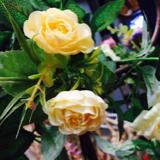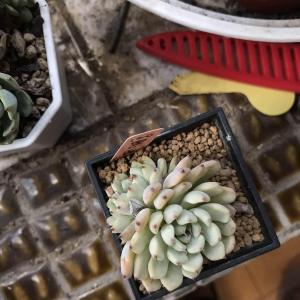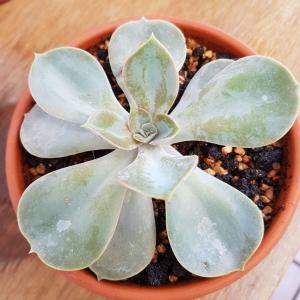文章
我家狗狗会尖叫
2017年07月23日

萱草以分株繁殖为主,春、秋季均可进行,但以春季为主。分株后夏季就可以开花。每年2〜3月挖取地下宿根,剪去枯根及过多的须根,3〜5芽分栽一盆。露地栽植的株行距0.5-0.8m,每穴种植4〜5株。穴内先放堆肥盖上细土,再将植株栽于穴内。种植不宜太深,土壅至根颈处即可。种植时注意不要损坏叶芽,栽后施足水分。人冬前施腐熟堆肥一次,生长期按一般肥水管理进行。一般3~5年分株一次。盆栽结合分株每年换盆一次。

繁殖方法
繁殖方法以分株繁殖为主,育种时用播种繁殖。分株繁殖于叶枯萎后或早春萌发前进行,将根株掘起剪去枯根及过多的须根,分株即可。一次分株后可4~5年后再分株,分株苗当年即可开花。种子繁殖宜秋播,一般播后4星期左右出苗。夏秋种子采下后如立即播种,20天左右出苗。播种苗培育2年后开花。
栽培管理
栽培管理简单粗放,株行距0.5×1米左右,每穴栽3~5株。栽前施足基肥。由于萱草适应性强,几乎随处可种,任其生长,株丛可年年不断扩大,但在庭园配植时应按株高和花色进行搭配,以提高观赏效果。
栽培要点
喜温暖湿润环境。土壤以稍带粘性较好。可在田坎、水沟边、住宅旁等处栽培。分株繁殖。10~11月地上部枯萎后或春季植株未萌芽前,挖起全株,每2、3等分为一丛。
栽前,按行、株距各40cm开穴,穴深17~20cm,每穴栽一丛,根要向四面平铺,盖土压紧。浇水或灌浇人畜粪水。自第二年起,每年中耕除草和追肥3次,第一次在3月出苗时,第二次在6月开花前,第三次在10月倒苗后,每次中耕除草后,施用人畜粪水。
病虫害防治
萱草常见的病害有叶斑病、叶枯病、锈病、炭疽病和茎枯病等:虫害主要有红蜘蛛、蚜虫、蓟马、潜叶蝇等。
防治病虫害:首先要搞好农业防治,在黄花菜采摘完后,地上部随即枯死,应及时割蔸并运离黄花菜地外,以减少菌源、虫源;搞好黄花菜的追肥、冬培工作,以增强抗病能力;适时更新复壮老蔸;选用抗病品种等。适时用药防治,病害可用75%的百菌清800倍液喷雾防治,虫害可用艾美乐3000倍喷雾防治。
萱草也可播种繁殖,种子随采随播,次春出芽,如在下年春播,当年不能发芽出苗。萱草易遭蚜虫为害,喷40%氧化乐果1500倍液防治。

繁殖方法
繁殖方法以分株繁殖为主,育种时用播种繁殖。分株繁殖于叶枯萎后或早春萌发前进行,将根株掘起剪去枯根及过多的须根,分株即可。一次分株后可4~5年后再分株,分株苗当年即可开花。种子繁殖宜秋播,一般播后4星期左右出苗。夏秋种子采下后如立即播种,20天左右出苗。播种苗培育2年后开花。
栽培管理
栽培管理简单粗放,株行距0.5×1米左右,每穴栽3~5株。栽前施足基肥。由于萱草适应性强,几乎随处可种,任其生长,株丛可年年不断扩大,但在庭园配植时应按株高和花色进行搭配,以提高观赏效果。
栽培要点
喜温暖湿润环境。土壤以稍带粘性较好。可在田坎、水沟边、住宅旁等处栽培。分株繁殖。10~11月地上部枯萎后或春季植株未萌芽前,挖起全株,每2、3等分为一丛。
栽前,按行、株距各40cm开穴,穴深17~20cm,每穴栽一丛,根要向四面平铺,盖土压紧。浇水或灌浇人畜粪水。自第二年起,每年中耕除草和追肥3次,第一次在3月出苗时,第二次在6月开花前,第三次在10月倒苗后,每次中耕除草后,施用人畜粪水。
病虫害防治
萱草常见的病害有叶斑病、叶枯病、锈病、炭疽病和茎枯病等:虫害主要有红蜘蛛、蚜虫、蓟马、潜叶蝇等。
防治病虫害:首先要搞好农业防治,在黄花菜采摘完后,地上部随即枯死,应及时割蔸并运离黄花菜地外,以减少菌源、虫源;搞好黄花菜的追肥、冬培工作,以增强抗病能力;适时更新复壮老蔸;选用抗病品种等。适时用药防治,病害可用75%的百菌清800倍液喷雾防治,虫害可用艾美乐3000倍喷雾防治。
萱草也可播种繁殖,种子随采随播,次春出芽,如在下年春播,当年不能发芽出苗。萱草易遭蚜虫为害,喷40%氧化乐果1500倍液防治。
0
1
文章
权问薇
2017年07月23日


红点草的播种繁殖
红点草的播种繁殖适宜于春、秋两季进行,栽培基质以疏松、肥沃的砂质壤土为宜,并且事先施好基肥,再进行播种,种子的发芽适温为20℃-24℃左右,一般播后约5-10天即可发芽,之后的生长温度需要保持在15℃-25℃左右,并放置于通风良好的半阴环境中。

红点草的扦插繁殖
采用扦插方式进行,具有成活率高的优点。首先,剪取饱满、生长健壮的红点草顶芽或者枝条,枝条每段2-3节,将其插入砂床中,并且保持适宜的湿度与温度,在扦插期间,还可以使用速大多稀释1000倍对其进行喷洒,一般每隔十天可喷一次,以促进其发根,这样大概经过3-4周后就能发根了。
0
0
文章
Dummer. ゛☀
2017年07月23日

Family - Caryophyllaceae
Stems - To +/-80cm tall, herbaceous, simple to branching above, from a taproot, glabrous to hirsute and antrorse pubescent near the inflorescence, terete, hollow.
Leaves - Opposite, sessile, linear, pubescent, to +/-6cm long, +/-5mm broad, entire, acute to obtuse.

Inflorescence - Terminal bracteate clusters of paired flowers. Bracts linear, pubescent. Flowers sessile.
Flowers - Petals 5, clawed. Claw to 1.5cm long, glabrous, white. Limb pink with white and rose mottling, 6-7mm long, 3mm broad, elliptic, toothed at apex. Stamens 10. Filaments to 1.4cm long, filiform, glabrous, white. Anthers purple, 1.2mm long, slightly exserted or included. Styles 2, filiform, white, 1cm long, included. Ovary cylindric, 6-7mm long, 1.2mm in diameter, glabrous, light green, 2-locular. Placentation axile. Ovules many. Calyx tube to 1.5cm long, 2.5mm in diameter, pubescent, 5-lobed. Lobes 3mm long, attenuate, erect.

Flowering - May - October.
Habitat - Open woods, roadsides, railroads, waste ground, pastures, fields. Also cultivated.
Origin - Native to Europe.
Other info. - This diminutive species can be found throughout Missouri. The bright pink flowers of this species make it desirable in cultivation and it requires little care.
Stems - To +/-80cm tall, herbaceous, simple to branching above, from a taproot, glabrous to hirsute and antrorse pubescent near the inflorescence, terete, hollow.

Leaves - Opposite, sessile, linear, pubescent, to +/-6cm long, +/-5mm broad, entire, acute to obtuse.

Inflorescence - Terminal bracteate clusters of paired flowers. Bracts linear, pubescent. Flowers sessile.
Flowers - Petals 5, clawed. Claw to 1.5cm long, glabrous, white. Limb pink with white and rose mottling, 6-7mm long, 3mm broad, elliptic, toothed at apex. Stamens 10. Filaments to 1.4cm long, filiform, glabrous, white. Anthers purple, 1.2mm long, slightly exserted or included. Styles 2, filiform, white, 1cm long, included. Ovary cylindric, 6-7mm long, 1.2mm in diameter, glabrous, light green, 2-locular. Placentation axile. Ovules many. Calyx tube to 1.5cm long, 2.5mm in diameter, pubescent, 5-lobed. Lobes 3mm long, attenuate, erect.

Flowering - May - October.
Habitat - Open woods, roadsides, railroads, waste ground, pastures, fields. Also cultivated.
Origin - Native to Europe.
Other info. - This diminutive species can be found throughout Missouri. The bright pink flowers of this species make it desirable in cultivation and it requires little care.
0
0
文章
Miss Chen
2017年07月19日


Nombre científico o latino: Caragana arborescens
Nombre común o vulgar: Caragana, Acacia de Rusia, Arbusto del guisante.
Familia: Fabaceae.
Origen: Siberia.
Arbustos de hoja caduca.
Altura: 2-5 metros.
Forma redondeada.
Posee ramas espinosas.
Hojas: paripinnadas con 8/12 folíolos y con estipulas muy cortas.
Floración muy abundante de color amarillo vivo.
Floración a final de primavera.

Uso como arbusto o árbol pequeño de macizos.
Leguminosa de clima continental.
Luz: sol, semisombra.
Suelo: cualquiera, incluso calizo, pero bien drenado.
Multiplicación: por semillas.
0
0
文章
Dummer. ゛☀
2017年07月18日

Family - Brassicaceae
Stems - To +20cm tall, erect, herbaceous, from a taproot, pubescent below, less so to glabrous above, often reddish in strong sun, typically branching near the base.

Leaves - Alternate, pinnately divided (pinnatifid) with 5-14 divisions on each side of the axis, to +4cm long, +1cm broad. Petioles and rachis pubescent. Divisions of the leaves acute, reduced basally, typically entire or with a small basal lobe, subulate to lanceolate glabrous or with one or two hairs near the apex. Leaves overwintering as a basal rosette.

Inflorescence - Terminal and axillary racemes, compact in flower, quickly expanding in fruit to more than 2/3 of the total plant height. Pedicels short (1-3mm) in flower, elongating to +4mm in fruit, glabrous.
Flowers - Petals 4, white, distinct, to 3mm long, 1mm broad, rounded at the apex, glabrous. Stamens 6, erect. Filaments to -2mm long, glabrous, translucent-white. Anthers yellow, .2mm long. Ovary cylindric, green to purple, glabrous, 1-2mm long in flower, quickly expanding. Style wanting. Sepals 4, distinct, whitish-green to purplish in strong sun, erect, glabrous, to 2mm long, 1mm broad, oblong-lanceolate, subacute to blunt at the apex. Fruits to +2cm long, 2mm broad, glabrous, moderately compressed ascending, with a -1mm long beak, 2-valved, divided by a septum, with +/-15 seeds per valve.

Flowering - March - May.
Habitat - Disturbed sites, waste ground, fallow fields, cultivated fields, roadsides, railroads.
Origin - Native to U.S.
Other info. - This little weedy species can be found mainly in the southern 2/3 of Missouri. The plant can be identified by its pinnately divided leaves, pubescent stems, small white flowers, and slightly compressed fruits.
Stems - To +20cm tall, erect, herbaceous, from a taproot, pubescent below, less so to glabrous above, often reddish in strong sun, typically branching near the base.

Leaves - Alternate, pinnately divided (pinnatifid) with 5-14 divisions on each side of the axis, to +4cm long, +1cm broad. Petioles and rachis pubescent. Divisions of the leaves acute, reduced basally, typically entire or with a small basal lobe, subulate to lanceolate glabrous or with one or two hairs near the apex. Leaves overwintering as a basal rosette.

Inflorescence - Terminal and axillary racemes, compact in flower, quickly expanding in fruit to more than 2/3 of the total plant height. Pedicels short (1-3mm) in flower, elongating to +4mm in fruit, glabrous.
Flowers - Petals 4, white, distinct, to 3mm long, 1mm broad, rounded at the apex, glabrous. Stamens 6, erect. Filaments to -2mm long, glabrous, translucent-white. Anthers yellow, .2mm long. Ovary cylindric, green to purple, glabrous, 1-2mm long in flower, quickly expanding. Style wanting. Sepals 4, distinct, whitish-green to purplish in strong sun, erect, glabrous, to 2mm long, 1mm broad, oblong-lanceolate, subacute to blunt at the apex. Fruits to +2cm long, 2mm broad, glabrous, moderately compressed ascending, with a -1mm long beak, 2-valved, divided by a septum, with +/-15 seeds per valve.

Flowering - March - May.
Habitat - Disturbed sites, waste ground, fallow fields, cultivated fields, roadsides, railroads.
Origin - Native to U.S.
Other info. - This little weedy species can be found mainly in the southern 2/3 of Missouri. The plant can be identified by its pinnately divided leaves, pubescent stems, small white flowers, and slightly compressed fruits.
0
0
文章
Miss Chen
2017年07月17日


Nombre científico o latino: Amelanchier canadensis
Nombre común o vulgar: Guillomo del Canadá, Cornillo, Carrasquilla
Familia: Rosaceae.
Origen: Norteamérica (región Este).
Altura: 2-5 m.
Hoja caduca. Ornamental por el color rojo otoñal fuego.
Florece al principio de primavera.

Interesante por su abundante floración primaveral.
Las bayas son comestibles.
Se utiliza generalmente formando grupos o aislado. Bueno para setos libres.
Sol o semisombra.
Suelo rico y bien drenajo, aunque no demasiado secos. Contenido en nutrientes medio.
Resistente a plagas, algún pulgón.
Multiplicación: semilla, esquejes y acodos.
0
0
文章
Colour_
2017年07月17日


勒杜鹃花的养殖方法:温度
生长适温为15-30℃,在夏季应适当遮荫或采取喷水、通风等措施,冬季应维持不低于5℃的环境温度。
勒杜鹃花的养殖方法:科学管水
即浇水、控水、重浇水三点结合。初夏生长季节,每天浇一次水,保证枝叶生长。6至7月,根据不同品种适当控水3至4 次,控水程度为使枝梢和叶片稍萎蔫。这时每天向叶片喷水1至2次,待2至3天后浇透水。反复控水几次或隔天浇水,可促进花芽分化。当新梢出现花蕾时,每天早晚各浇一次重水,并向叶面喷水1至2次。10 月后视土壤的干湿程度适当浇水。冬季入室后,保持不干不浇,浇则浇透。
勒杜鹃花的养殖方法:施肥得当
勒杜鹃花开花多,花期长,养分消耗多,加上盆土有限,一定要定期补充肥料。春季换盆时,施足基肥,根据花盆大小,每盆施10至15克腐熟鸡粪干或饼肥,出室后追施速效氮肥。生长旺盛期,每隔7天施腐熟饼肥水,加速花芽分化。当叶腋出现花蕾时,可多施肥、施大肥,以磷钾肥为主。夏季盛花期,每3至5天施一次矾肥水,每7天喷0.3%磷酸二氢钾。8至10月更要大肥大水,以肥代水,用矾肥水或饼肥水浇施。
勒杜鹃花的养殖方法:日照
日照要长、光照要强。盆栽三角梅,只要光、温、水、肥满足,一年四季都可开花。每天日照10至12小时,光照强、通风条件好,花期可达到180至200天。其中紫色三角梅可开到春节,清明出室后,五一节又可鲜花怒放。
勒杜鹃花的养殖方法:修剪
叶子花生长势强,因此每年需要整形修剪,叶子花常用扦插繁殖,育苗容易,五、六月份,剪取成熟的木质化枝条,长20厘米,插入砂盆中,盖上玻璃,保持湿润,一个月左右可生根,培养二年可开花。修剪方法:开花后应适度修剪,剪去花梗,缩回花枝1/3的枝条,疏去弱枝、短枝、内膛枝。冬季结合换盆土修剪,修剪应掌握:短、重、疏。短,为短截,保留枝条的1/3;重,为重剪长花枝;疏,为疏去弱枝,使其重发强枝,也称更新修剪,剪下的枝条可选留作育苗插条用。南方用三角梅作花架、篱笆、门庭栽植的,冬季不休眠、不落叶,只做轻度修剪,但应做绑缚、分布、牵引,使花架的枝条分布均匀合理,布满花架。

0
2
文章
Colour_
2017年07月17日

红宝石的养殖技巧

土壤:
红宝石的土壤可以采用煤渣混合泥炭、少量珍珠岩,比例大概5:4:1。
光照:
红宝石需要全日照,红宝石的叶片向内凹陷有明显的波折,强光下或者温差大,叶片会泛红。弱光则叶色会变成绿色,叶片拉长,颜色也变的有点浅绿。红宝石叶面光滑,不容易积水。叶片微白粉,红宝石需要接受充足日照叶色才会艳丽,株型才会更紧实美观。
温度及浇水:
红宝石生长期需保持土壤湿润,避免积水。红宝石能耐零下4℃左右的低温,是室内的温度,非露天,再低叶片的顶端生长点就会出现冻伤,干枯死亡,整个冬季基本断水,5度以下就要开始慢慢断水。夏季高温时整个植株生长缓慢或完全停止,这个时候要通风良好且适当遮光,避免曝晒,节制浇水,不能长期雨淋,以免植株腐烂。
红宝石的养护方法
红宝石需要阳光充足和凉爽、干燥的环境,耐半阴,怕水涝,忌闷热潮湿。具有冷凉季节生长,夏季高温休眠的习性。每年的9月至第二年的6月为植株的生长期,若光照不足会使植株叶片徒长,叶片颜色也会变成绿色;而在阳光充足之处生长的植株,株型矮壮,叶片排列会紧凑。
多肉植物红宝石怎么种养,红宝石的养殖养护方法,小编就给大家介绍到这了。红宝石群生后,植株会非常壮观,特别是多年修剪过的老桩。红宝石簇状花序花色红粉色,和大多数的石莲花一样的花型。

红宝石病虫害防治
红蜘蛛:一般因空气干燥所引起的 ,用一些杀螨类药剂防治:用2000倍克螨特,1500倍三氯杀螨乙醇防治。
蓟马:秋冬季节蓟马危害比较严重,先由蓟马危害,在叶片上产生一点、一点的伤口,然后伤口引起病菌感染,产生病斑。所以生产上注意对蓟马进行防治。可用啶虫咪1500倍或万灵3000倍进行防治。
红宝石观赏价值
叶柄长而粗壮,气生根极发达粗壮,纷然披垂,将其布置室内,大方清雅,富热带雨林气氛。是好的观叶植物,现在我国中南部各省广泛栽培。

土壤:
红宝石的土壤可以采用煤渣混合泥炭、少量珍珠岩,比例大概5:4:1。
光照:
红宝石需要全日照,红宝石的叶片向内凹陷有明显的波折,强光下或者温差大,叶片会泛红。弱光则叶色会变成绿色,叶片拉长,颜色也变的有点浅绿。红宝石叶面光滑,不容易积水。叶片微白粉,红宝石需要接受充足日照叶色才会艳丽,株型才会更紧实美观。
温度及浇水:
红宝石生长期需保持土壤湿润,避免积水。红宝石能耐零下4℃左右的低温,是室内的温度,非露天,再低叶片的顶端生长点就会出现冻伤,干枯死亡,整个冬季基本断水,5度以下就要开始慢慢断水。夏季高温时整个植株生长缓慢或完全停止,这个时候要通风良好且适当遮光,避免曝晒,节制浇水,不能长期雨淋,以免植株腐烂。
红宝石的养护方法
红宝石需要阳光充足和凉爽、干燥的环境,耐半阴,怕水涝,忌闷热潮湿。具有冷凉季节生长,夏季高温休眠的习性。每年的9月至第二年的6月为植株的生长期,若光照不足会使植株叶片徒长,叶片颜色也会变成绿色;而在阳光充足之处生长的植株,株型矮壮,叶片排列会紧凑。
多肉植物红宝石怎么种养,红宝石的养殖养护方法,小编就给大家介绍到这了。红宝石群生后,植株会非常壮观,特别是多年修剪过的老桩。红宝石簇状花序花色红粉色,和大多数的石莲花一样的花型。

红宝石病虫害防治
红蜘蛛:一般因空气干燥所引起的 ,用一些杀螨类药剂防治:用2000倍克螨特,1500倍三氯杀螨乙醇防治。
蓟马:秋冬季节蓟马危害比较严重,先由蓟马危害,在叶片上产生一点、一点的伤口,然后伤口引起病菌感染,产生病斑。所以生产上注意对蓟马进行防治。可用啶虫咪1500倍或万灵3000倍进行防治。
红宝石观赏价值
叶柄长而粗壮,气生根极发达粗壮,纷然披垂,将其布置室内,大方清雅,富热带雨林气氛。是好的观叶植物,现在我国中南部各省广泛栽培。
2
6
文章
Colour_
2017年07月17日


玫瑰花的养殖方法
1、温度:喜温暧,生长的最适宜温度为15~25,在5°C以下的低温时生长不良或停止生长。能耐寒,冬季能忍耐-10的低温,长江流域能露地越冬。不甚耐高温,在38以上的温度时,植物生长不良或停止生长。
2、光照:喜阳光,光照不足时植株生长瘦弱,开花少且香味淡。盛夏时,应遮去中午前后的强烈阳光。
3、浇水:耐干旱,但盆栽植株在生长期间要保持盆土湿润,才能保证植株的正常生长与开花,过于干旱时不易开花。不耐水湿,盆土过湿或积水,易引起植株的烂根。开花前后要控制浇水量;越冬落叶休眠时对水分的需求较少,更应控制浇水,不让盆土过湿。但如遇强冷空气侵袭时,应及时浇水,保持盆土湿润,可有利于保暖防冻。
4、环境湿度:4~5月孕蕾时,应在每天傍晚向植株喷水,以利于花蕾的膨大和开放。
5、施肥:喜肥,过于贫瘠时不易开花。盆栽植株生长期间每10天需追施1次肥料,前期的施肥应以氮为主;孕蕾时要增施磷肥,忌单纯施用氮肥;开花期停止施肥。地栽植株落叶后要施足基肥,翌年早春再施1次氮肥,以促发新枝并使枝条生长健壮。
6、修剪:因花开于当年萌发的新枝上,因此应在萌芽前进行一次修剪。除将老弱枝、枯枝、过密枝疏剪外,还要对留下的枝条进行强剪。每盆只需保留3~4根枝干,每根留5~8厘米重剪,以促其萌生粗壮的新枝。生长期除在植株过于繁茂时进行适当疏剪外,一般不作修剪。开花期应及时摘去残花,可利于以后的开花I如果不摘,一年只能开花1次I若进行摘花,可使植株多次开花。萌蘖力极强,根的寿命可达20年左右,但老株超过10年多不开花,故5~7年需进行一次更新。
7、翻盆:每年春天珲行一次翻盆。喜肥沃、排水良好的砂质壤土,在微碱性土壤中也能生长。基质可用园土、腐叶土、粗砂或珍珠岩等材料配制。
病虫害防治:有白粉病、锈病和介壳虫、蚜虫、月季茎蜂、红蜘蛛等病虫危害。患锈病时,叶片出现淡黄色病斑,叶背生有黄色粉状物,并逐渐枯死。
8、常见问题及其原因:植株枝干细瘦,开花少且香味不浓常为光照不足所致
①光照不足;②盆土过于干燥;⑤盆土过于贫瘠;④没有修剪,开花后没有摘去残花;⑤长期没有翻盆。
叶片出现病斑,并逐渐枯死是患锈病的缘故
9、观赏及保健作用:玫瑰为香花观赏植物,在园林中宜作花篱、花境、花坛,也可盆栽装饰窗台、庭院等处。
玫瑰的气味能杀灭结核杆菌、肺炎球菌、葡萄球菌等;其香味能宽胸活血,可防冠心病,并可让急躁的心情变得温和、宁静,令人身心爽朗快乐;对空气中的二氧化硫也有一定的吸收能力。

2
8
文章
Dummer. ゛☀
2017年07月16日

Family - Liliaceae
Stems - Bulbs. Aerial stem glabrous, 20-30cm tall, +/-4mm in diameter.
Leaves - Linear, grasslike, entire, basal, glabrous, +20cm long, 5-6mm broad, often involute, with a light green to whitish midrib.
Inflorescence - Raceme to +8cm tall. Pedicels glaucous, to +4cm long, 2mm in diameter. Single bracts at base of pedicels to 4cm long, scarious, 4mm broad at base, attenuate.
Flowers - Tepals 6, white above, white with green stripe below, glabrous, free, oblong to linear, 1.5cm long, 5mm broad. Stamens 6, erect, slightly exserted. Anthers flattened, 7mm long, 2mm broad at base, keeled, connivent around ovary. Anthers yellow, 2.5cm long, 1.2mm broad. Ovary superior, with 6 ridges, 3-locular, many seeded, placentation axile. Style 1, 2.5-3mm long, white, glabrous. Flowers highly nectariferous.

Flowering - April - June.
Habitat - Cultivated and escaped into open fields, waste ground, parks, open woods, roadsides, railroads.
Origin - Native to Europe.
Other info. - Like many of the lilies, this plant is toxic. Apparently it is quick to spread and hence easy to propagate. The individual flowers don't last long, only a couple of days, but the plant produces many flowers and is certainly striking.
Stems - Bulbs. Aerial stem glabrous, 20-30cm tall, +/-4mm in diameter.
Leaves - Linear, grasslike, entire, basal, glabrous, +20cm long, 5-6mm broad, often involute, with a light green to whitish midrib.

Inflorescence - Raceme to +8cm tall. Pedicels glaucous, to +4cm long, 2mm in diameter. Single bracts at base of pedicels to 4cm long, scarious, 4mm broad at base, attenuate.

Flowers - Tepals 6, white above, white with green stripe below, glabrous, free, oblong to linear, 1.5cm long, 5mm broad. Stamens 6, erect, slightly exserted. Anthers flattened, 7mm long, 2mm broad at base, keeled, connivent around ovary. Anthers yellow, 2.5cm long, 1.2mm broad. Ovary superior, with 6 ridges, 3-locular, many seeded, placentation axile. Style 1, 2.5-3mm long, white, glabrous. Flowers highly nectariferous.

Flowering - April - June.
Habitat - Cultivated and escaped into open fields, waste ground, parks, open woods, roadsides, railroads.
Origin - Native to Europe.
Other info. - Like many of the lilies, this plant is toxic. Apparently it is quick to spread and hence easy to propagate. The individual flowers don't last long, only a couple of days, but the plant produces many flowers and is certainly striking.
0
0
文章
Dummer. ゛☀
2017年07月16日

Family - Campanulaceae
Stems - Simple, erect, to +/-50cm tall, glabrous to variously pubescent, herbaceous, 4-5 angled.
Leaves - Mostly in lower 1/2 of stem, sessile or short petiolate (near base of stem), spatulate to oblong, rounded at apex, entire to irregularly dentate (margins strigillose to ciliate), +/-5cm long, +/-2cm broad, sparse strigose to glabrous.
Inflorescence - Terminal spikiform raceme to +/-35cm long (tall). Each flower subtended by a lance-linear to subulate bract to 1.5cm long, 3mm broad. Bracts typically glabrous. Pedicels to 3mm long, glabrous to pubescent.
Flowers - Resupinate. Corolla whitish to lilac, to 1.3mm long, 5-lobed. Three "upper" lobes to 4.1mm long, 2mm broad, oblanceolate to lanceolate. Two "lower" lobes deflexed to reflexed, 3mm long. Stamens 5, adnate at base of corolla tube. Filaments white, pubescent at base. Anthers purplish-blue, connate around stigma. Stigma purple, bearded at base. Style 1, 5mm long, glabrous, greenish. Ovary ovoid-conic, slightly compressed, green, 2-locular. Placentation axile. Calyx tube +/-1mm long, 5-lobed. Lobes auricled at base, 3mm long, -1mm broad at base, linear-attenuate. Auricles various. Capsule to 8mm long, +/-4mm in diameter, glabrous to pubescent.
Flowering - May - August.
Habitat - Prairies, glades, open woods, bluffs, wet meadows.
Origin - Native to U.S.
Other info. - This is a highly variable species. The flowers can be bluish to white, the stems can be glabrous to hispid, and the calyx lobes can have variable auricles at their bases. The anthers of the plant can also be variable in color sometimes. Steyermark breaks the species apart into 4 different varieties but these varieties integrade and can be difficult to distinguish so I won't mention them here.
Remember, the flowers are inverted (resupinate) on this plant so what looks like the top of the flower is actually the bottom and vice-versa.
Stems - Simple, erect, to +/-50cm tall, glabrous to variously pubescent, herbaceous, 4-5 angled.

Leaves - Mostly in lower 1/2 of stem, sessile or short petiolate (near base of stem), spatulate to oblong, rounded at apex, entire to irregularly dentate (margins strigillose to ciliate), +/-5cm long, +/-2cm broad, sparse strigose to glabrous.
Inflorescence - Terminal spikiform raceme to +/-35cm long (tall). Each flower subtended by a lance-linear to subulate bract to 1.5cm long, 3mm broad. Bracts typically glabrous. Pedicels to 3mm long, glabrous to pubescent.

Flowers - Resupinate. Corolla whitish to lilac, to 1.3mm long, 5-lobed. Three "upper" lobes to 4.1mm long, 2mm broad, oblanceolate to lanceolate. Two "lower" lobes deflexed to reflexed, 3mm long. Stamens 5, adnate at base of corolla tube. Filaments white, pubescent at base. Anthers purplish-blue, connate around stigma. Stigma purple, bearded at base. Style 1, 5mm long, glabrous, greenish. Ovary ovoid-conic, slightly compressed, green, 2-locular. Placentation axile. Calyx tube +/-1mm long, 5-lobed. Lobes auricled at base, 3mm long, -1mm broad at base, linear-attenuate. Auricles various. Capsule to 8mm long, +/-4mm in diameter, glabrous to pubescent.

Flowering - May - August.
Habitat - Prairies, glades, open woods, bluffs, wet meadows.
Origin - Native to U.S.
Other info. - This is a highly variable species. The flowers can be bluish to white, the stems can be glabrous to hispid, and the calyx lobes can have variable auricles at their bases. The anthers of the plant can also be variable in color sometimes. Steyermark breaks the species apart into 4 different varieties but these varieties integrade and can be difficult to distinguish so I won't mention them here.
Remember, the flowers are inverted (resupinate) on this plant so what looks like the top of the flower is actually the bottom and vice-versa.
0
0














